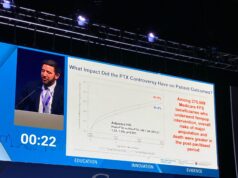A real-world safety analysis of paclitaxel-based devices in peripheral arteries, recently published in the European Heart Journal, showed no evidence for increased mortality over a period of 11 years. “In summary,” the authors remark, “our analysis found the use of drug-eluting devices to be safe for endovascular therapy of the lower limbs”.
Elaborating on the findings, they comment that “Particularly with regard to long-term mortality, neither drug-coated balloons nor drug-eluting stents was associated with increased risk compared to non-drug-eluting devices”. Furthermore, they say the analysis “exemplarily demonstrates the significance of health claims data for assessing urgent safety concerns without undue delay”.
In 9.2 million insurants of the German BARMER Health Insurance, Eva Freisinger (University Hospital Münster, Germany) and colleagues retrieved data on the application of paclitaxel-based drug-eluting stents (DES) and drug-coated balloons (DCB) from their introduction on the market in 2007 until the present.
They then indexed all patients with first endovascular revascularisation between 2007 and 2015 and followed them until 31 December 2017. Freisinger and colleagues included each subsequently applied DES, DCB, bare-metal stent, and uncoated balloon in further analysis.
Multivariable Cox regression analysis considered potential non-linear time-dependent hazard ratios of DES and DCB over 11 years. The authors identified 64,771 patients who underwent 107,112 endovascular revascularisation procedures using 23,137 drug-eluting devices (DED).
The investigators report that this analysis showed paclitaxel-based DES not to be associated with increased long-term mortality for over 11 years past application (all p>0.057). DCB was associated with decreased long-term mortality for the first year past application (HR 0.92; p<0.001), and indifferent correlation in the years thereafter (all p>0.202).
Addressing the significance of the study, the authors remark: “Our study debilitates current safety concerns resulting from previous findings,” referring to recent data which has indicated a two-fold increase in long-term mortality among patients treated with paclitaxel-based DED.
While DED represent a well-established therapy being widely used for endovascular revascularisation for peripheral vessels, the authors note, these safety concerns affected international regulatory authorities to call for several alerts for further application of DED.
“Compared to the meta-analysis by Katsanos et al that resulted from small-sized selected cohorts of the underlying RCTs,” Freisinger and colleagues continue, “our data reflect the unselected real-world patient collective to which the devices actually apply to.”
Commenting on the patient cohort, they say it is “representative compared to other large epidemiological studies in terms of age, sex, cardiovascular risk burden, and LEAD [lower extremity artery disease] severity,” referring directly to studies by Olinic et al and Fowkes et al.
While the authors stress that the present analysis covers a “large and comprehensive” database of unselected real-world patients, they admit that it is limited by the “general constraints” in the use of secondary healthcare data. Specifically, they note, real-world administrative data do not provide information on the underlying reason for DED treatment, representing a potential selection bias.











